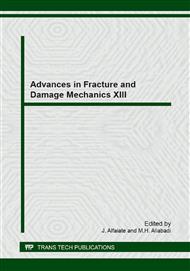p.137
p.141
p.145
p.149
p.153
p.157
p.161
p.165
p.169
Fatigue Crack Propagation in Thin Wires of Ultra-High Strength Steel
Abstract:
Fatigue crack propagation is studied in thin wires of about 1 mm in diameter of an ultrahigh strength steel (σmax> 2400MPa) in ambient air and in air with controlled residual humidity. A specific equipment is developed based on an electro-dynamic testing machine equipped with an environmental chamber for air humidity control. Threshold tests are run using a load shedding procedure specifically adapted to the specimen size. The relation between load ratio and crack closure is evaluated from constant Kmax tests. The results are discussed on the basis of fracture surface observations and of existing modelling for environmentally assisted fatigue crack propagation.
Info:
Periodical:
Pages:
153-156
Citation:
Online since:
September 2014
Authors:
Price:
Сopyright:
© 2015 Trans Tech Publications Ltd. All Rights Reserved
Share:
Citation:


